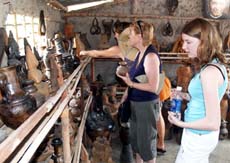Traditional craft villages are step by step insuring their important role in the socio-economic development and cultural life of the country. Craft village tourism development is the most effective way to eradicate poverty, build the new rural image and contribute to marketing the national image and trademark.
 According to Viet Nam Craft Village Association, currently, there are around 3,000 craft villages including 400 traditional craft villages with 53 craft groups attracting around 12 million labourers. Income of the local people in craft villages is three-five times as high as that of the ones involving in rural agricultural production. Therefore, craft village development is a proper and reasonable choice for many countries including Vietnam. Craft village development not only brings economic benefit, helps people improve their income, deals with the local employment issue but also helps maintain and preserves the traditional cultural values and gives vivid introduction on each region and locality in the country.
According to Viet Nam Craft Village Association, currently, there are around 3,000 craft villages including 400 traditional craft villages with 53 craft groups attracting around 12 million labourers. Income of the local people in craft villages is three-five times as high as that of the ones involving in rural agricultural production. Therefore, craft village development is a proper and reasonable choice for many countries including Vietnam. Craft village development not only brings economic benefit, helps people improve their income, deals with the local employment issue but also helps maintain and preserves the traditional cultural values and gives vivid introduction on each region and locality in the country.
However, according to Mr. Diep Kinh Tan, Vice Minister of Agriculture and Rural Development, despite that craft villages' products are abundant and rich in kinds, few have national and international trademark. Localities have not reasonable policies and mechanism to develop tourism craft villages. Management at different levels is still loose and overlapping. Currently, craft villages only focus on making normal products, failing to associate with tourism purpose while the local people are indifferent and incapable of exploiting historical and cultural values.
Mr. Katsuhiro, JICA's tourism development specialist emphasized the role of the local people in tourism development. He revealed that in the process of implementing craft village tourism development in Duong Lam (Hanoi), the local people had chances to work with responsible agencies in different project stages including conducting surveys, drawing tourism resource map and building tourism development programmes. Once they can recognize the humanity presented in each product, they will be eager to make contribution.
"In other countries, craft village associated with tourism development is conducted quite well. However, in Vietnam, the collaboration among relevant ministries is yet close, failing to issue any related policy and mechanism for the sake of this while Vietnam possesses great potentials", Mr. Diep Kinh Tan stated.
To develop tourism in association with rural craft villages, in the coming time, according to Mr. Tan, it is necessary to put forward several measures including promotion of investment in infrastructure in craft villages, focus on marketing of traditional craft products, enhancement of the ability to "do tourism business" for the local people and managers and development of key national products.